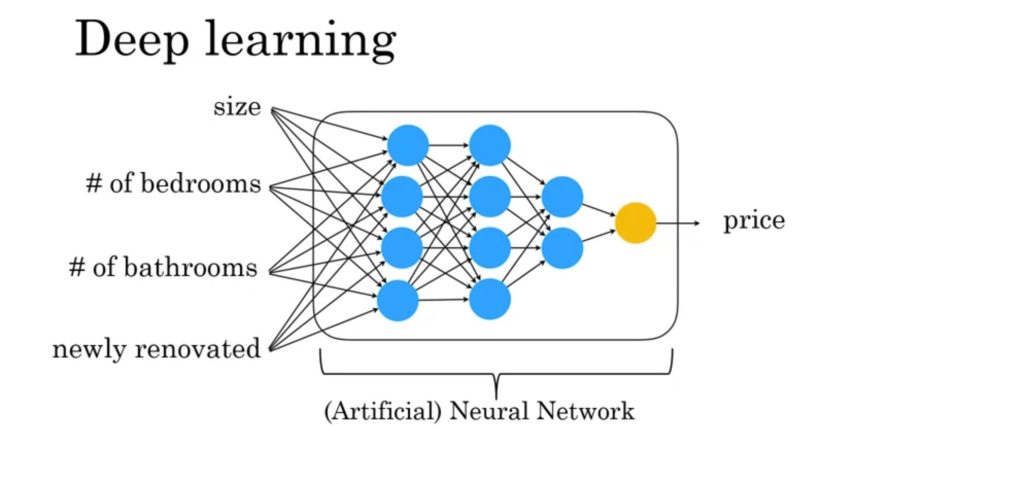If you’ve ever delved into the world of AI, you might have encountered terms like machine learning, data science, deep learning, and neural networks. But what exactly do these buzzwords mean, and how do they relate to each other? In this article, we’ll demystify these essential concepts in AI so you can confidently discuss and explore their applications in your business.
You might have heard terminology from AI, such as machine learning or data science or neural networks, or deep learning. What do these terms mean? In this video, you’ll see what is this terminology of the most important concepts of AI, so that you will speak with others about it and start thinking how these things could apply in your business. Let’s get started.
Machine Learning: Learning from Data
Imagine you have a dataset related to housing, containing information like house size, the number of bedrooms, the number of bathrooms, whether the house is newly renovated, and its price. If your goal is to create a mobile app that can predict house prices based on these inputs, you’re essentially building a machine-learning system.
A machine-learning system learns from input data (A) to make predictions or produce output (B). In this case, it learns the relationship between the features of a house (input A) and its price (output B). This software can run autonomously, providing price estimates day and night, making it a valuable tool for businesses.
For instance, major online ad platforms use machine learning to determine which ads are most likely to be clicked by users. These systems continuously analyze user data (input A) to predict ad clicks (output B), generating substantial revenue for these companies.
Data Science: Extracting Insights from Data
Data science, on the other hand, focuses on extracting knowledge and insights from data. It involves analyzing datasets to uncover valuable information that can guide business decisions.
For instance, a data science team might discover that houses with three bedrooms tend to have significantly higher prices than two-bedroom houses of the same size. Or they might find that newly renovated homes command a 15% premium in the market. These insights can inform decisions such as what types of houses to build or whether to invest in renovations.
In summary, data science projects result in insights presented in formats like PowerPoint presentations or reports. These insights empower executives and product teams to make informed choices.
The boundaries between machine learning and data science can be blurry, and the terminology isn’t always used consistently in the industry. However, the most commonly accepted definitions distinguish machine learning as a field that builds running AI systems and data science as a discipline focused on generating insights from data.
Deep Learning and Neural Networks
Deep learning is a subset of machine learning and is often used interchangeably with the term neural networks. It involves using artificial neural networks to model complex relationships between inputs (A) and outputs (B). Although inspired by the human brain, these artificial neural networks are distinct from biological brains.

Neural networks consist of artificial neurons that pass information to one another. They are particularly effective at learning intricate input-output mappings, making them a powerful tool for AI tasks.
In the realm of online advertising, deep learning is deployed to predict which ads a user is most likely to click on, contributing significantly to revenue generation. These neural networks run continuously, processing input data to predict user behavior.
The Landscape of AI Tools
AI encompasses a variety of tools and techniques, including unsupervised learning, reinforcement learning, graphical models, planning, knowledge graphs, and more. While you don’t need to know every term, it’s essential to grasp the core concepts like machine learning, data science, deep learning, and neural networks.
Machine learning, particularly deep learning, is at the forefront of AI innovation today. These techniques are vital for solving problems that involve mapping inputs to outputs, whether it’s predicting house prices or ad clicks.
In a broader context, AI is a vast toolbox for making computers perform intelligent actions. Machine learning, with its subset deep learning, forms a significant portion of this toolbox. However, AI also includes other tools and approaches, such as those mentioned earlier, for tackling various tasks.
The relationship between data science and AI can vary depending on how different experts view it. Some consider data science a subset of AI, while others see AI as a subset of data science. Ultimately, data science cuts across both AI and machine learning, employing a range of tools to extract valuable insights from data.
Wrapping It Up
In this article, we’ve unraveled the terminology of AI, clarifying concepts like machine learning, data science, deep learning, and neural networks. These terms represent crucial building blocks in the world of artificial intelligence. Understanding these concepts will empower you to explore AI’s potential applications in your business.
In the next article, we’ll delve into what it means for a company to excel in AI. Stay tuned for more insights on this fascinating journey into the world of artificial intelligence.


